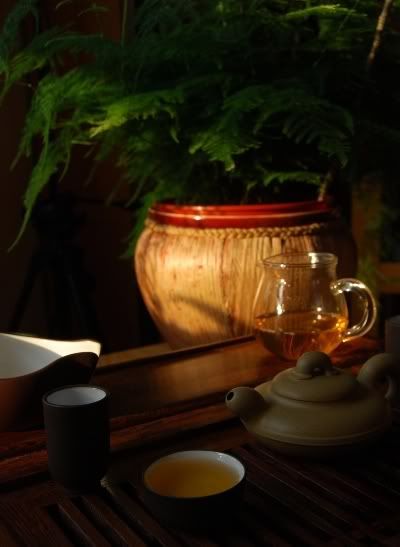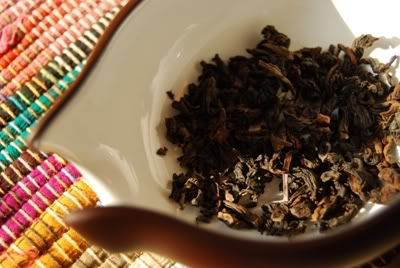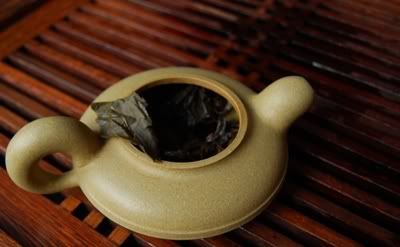Winging their way from the USA, bought in Taiwan during his Formosan explorations, this is "sample two" of four samples from MarshalN - many thanks indeed for an introduction into a genre with which I am wholly unfamiliar. Says he:
"There are four teas in them, including two aged tieguanyin, one aged baozhong, and one aged Taiwan oolong. One of them is what is normally passed on in most teashops as "aged oolong", but is in reality probably just a tea that is a few years old with a lot of roasting. I won't tell you which is which (numbered 1-4) unless you want me to."This tea makes a welcome break from writing my thesis on a warm Whitsun afternoon...
Armed with the knowledge that this requires "good water", I used some of my favourite "Scottish Mountain". The soup (above) is a clean yellow-orange. The first impact of this tea is its scent.
My dear wife has talking at length about literary criticism as she approached the tea-table; halfway through a strongly-made point, as she opened the wenxiangbei [aroma cup], and then immediately halted, mid-sentence: "...Oh, nice".
My dear wife has talking at length about literary criticism as she approached the tea-table; halfway through a strongly-made point, as she opened the wenxiangbei [aroma cup], and then immediately halted, mid-sentence: "...Oh, nice".
The aroma is thick and sweet; similar to a tea that Nada enjoyed with us during his visit, a feeling of definite chaqi is obtained from the aroma alone - something is transmitted in that scent, and collects at the back of the nose, then goes onwards into the body. An enjoyable complex of raisin and nuts continues for whole minutes in the narrow opening of the wenxiangbei.
Long and honey-like, with thick texture on the lips, this wulong is the first I have encountered that exhibits the cooling sensation I associate with post-menthol - a sign I always take to mean good leaf, in pu'er.
In the tall confines of the wenxiangbei, the roast and wulong scents combine during later infusions to form something akin to the aroma of stem ginger.
After the 4th or 5th infusion, the best of the tea is past, but it continues to provide sweet pleasures as long as we provide it the water to do so.
This tea is very calming on the stomach. After a spicy meal, and some hours spent bent over my thesis, I had developed a slightly aching tum - this tea banished that sensation entirely. A fine settler, and a tasty session.
In the tall confines of the wenxiangbei, the roast and wulong scents combine during later infusions to form something akin to the aroma of stem ginger.
After the 4th or 5th infusion, the best of the tea is past, but it continues to provide sweet pleasures as long as we provide it the water to do so.
This tea is very calming on the stomach. After a spicy meal, and some hours spent bent over my thesis, I had developed a slightly aching tum - this tea banished that sensation entirely. A fine settler, and a tasty session.




4 comments:
Greetings Hobbes,
First thank you to Marshall for supplying you some roasted tieguayin samples. I am curious to see your comments on the other samples.
The teapot you used for this tasting, was it a duani pot? Any thoughts on whether zisha, zuni or duani teapots work best with roasted tieguayin?
Glad to see the tea remedied your stomach woes.
Have a good tea,
Alex
Dear Alex,
The clay used for the teapot is hard to determine - it's just a cheap little factory pot, and so I suspect it is a mixture of all manner of random clays and muds!
When I pick teapots for teas, I like to find something that feels complementary to the nature of the tea. For roasted wulong, I like the pot shown in the photograph, because, in some hard-to-define manner, it seems somehow sympathetic to the qualities of roasted wulong. I usually drink roasted Buddha's Hand in it, and the rough, porous nature of the clay feels well-suited to the rough, darkly-roasted nature of the tea. It might be my imagination, but I find that it takes off the rough edges of the tea, and provides a smoother brew.
There are all manner of curious "facts" that you'll read about selecting teapots for teas - my advice is to go with your instinct, try a few out, and really satisfy yourself as to what works best for each tea - you are the final arbiter, and there are no real rules for matching pots to teas, no matter what vendors might write. :)
Toodlepip,
Hobbes
Hello Hobbes,
I agree with your principle that personal preference should be the ultimate guide in terms of pairing particular teapots with specific teas.
While I still need to test first hand the theory that Duanni teapots can round out the edges of the teas brewed in them, it had not occured to me brew a roasted tea in one. Something to look forward to :)!
Have a great tea day,
Alex
Dear Alex,
Let us know how you get on with the experiments. :)
Toodlepip,
Hobbes
Post a Comment